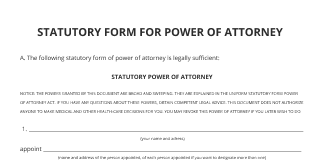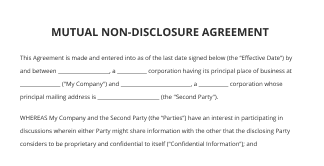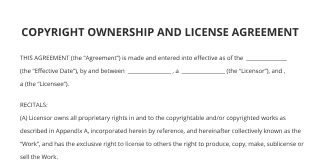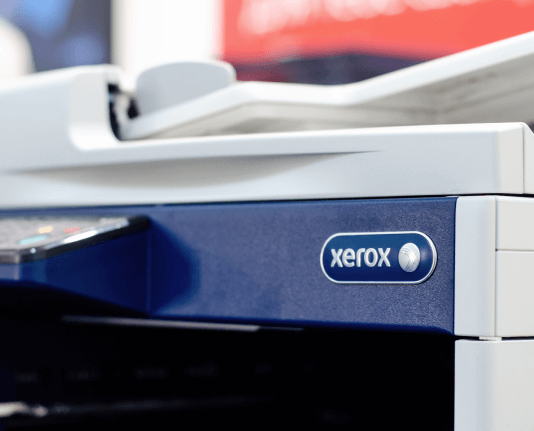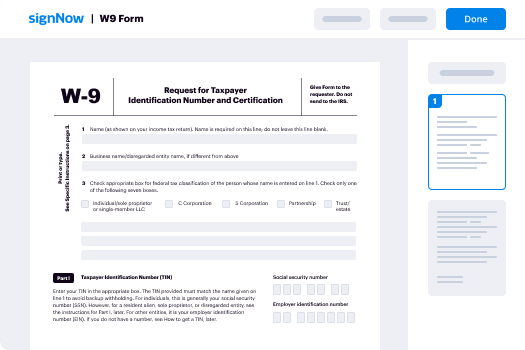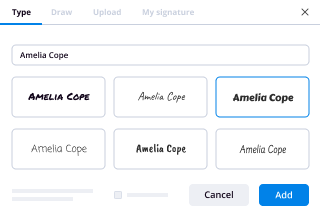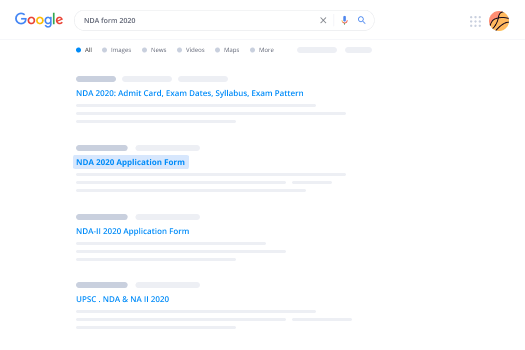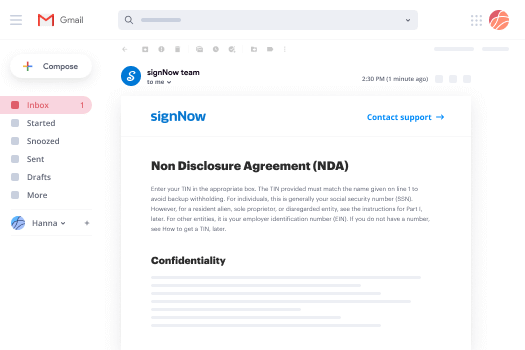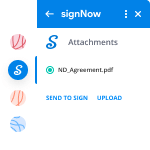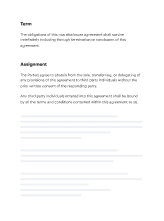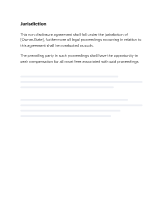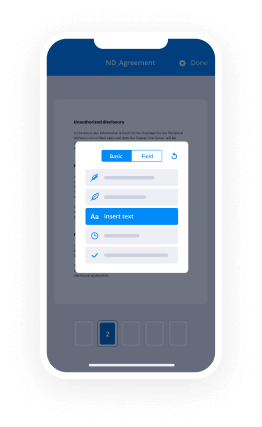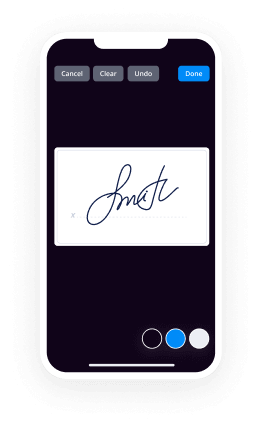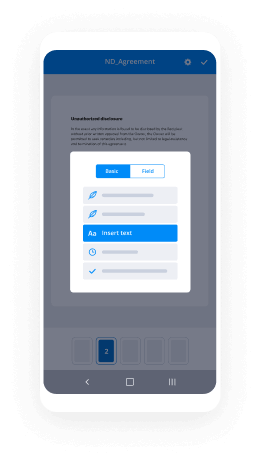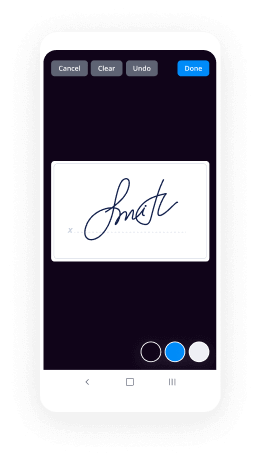Plantilla De Cotización De Pintura De Marca Fácil De Usar
Haz más en línea con una plataforma de firma electrónica de confianza global
Experiencia de firma destacada
Informes y análisis robustos
Firma electrónica móvil en persona y a distancia
Normas y conformidad de la industria
Plantilla de cotización de pintura de marca, más rápido que nunca
Complementos útiles de firma electrónica
Vea las firmas electrónicas de airSlate SignNow en acción
Soluciones de airSlate SignNow para una mayor eficiencia
Las reseñas de nuestros usuarios hablan por sí mismas






Por qué elegir airSlate SignNow
-
Prueba gratuita de 7 días. Elige el plan que necesitas y pruébalo sin riesgos.
-
Precios honestos para planes completos. airSlate SignNow ofrece planes de suscripción sin cargos adicionales ni tarifas ocultas al renovar.
-
Seguridad de nivel empresarial. airSlate SignNow te ayuda a cumplir con los estándares de seguridad globales.

Tu guía paso a paso — painting quote template
Al adoptar la firma electrónica de airSlate SignNow, cualquier organización puede acelerar los flujos de trabajo de firma y firmar en línea en tiempo real, proporcionando una experiencia mejorada a los clientes y empleados. Use la plantilla de Cotización de Pintura de marca en unos pocos pasos sencillos. Nuestras aplicaciones móviles hacen posible trabajar en movimiento, ¡incluso sin conexión! Firma contratos desde cualquier lugar del mundo y cierra tratos en poco tiempo.
Cómo completar y firmar un painting estimate template
- Inicie sesión en su perfil de airSlate SignNow.
- Encuentre su documento en sus carpetas o importe uno nuevo.
- Acceda a la plantilla y edite el contenido usando el menú Herramientas.
- Coloque cuadros rellenables, escriba contenido textual y fírmelo.
- Incluya varios firmantes usando sus correos electrónicos y configure la secuencia de firma.
- Elija qué usuarios pueden recibir un documento completo.
- Use Opciones avanzadas para limitar el acceso al documento y agregar una fecha de vencimiento.
- Haga clic en Guardar y cerrar cuando haya terminado.
Además, hay funciones más innovadoras disponibles para la plantilla de Cotización de Pintura de marca. Liste usuarios en su entorno de trabajo colaborativo, vea equipos y supervise la colaboración. Millones de usuarios en EE. UU. y Europa concuerdan en que una solución que integra todo en un solo lugar digital cohesivo, es lo que las empresas necesitan para mantener los flujos de trabajo funcionando sin problemas. La API REST de airSlate SignNow le permite integrar firmas electrónicas en su aplicación, sitio web, CRM o almacenamiento en la nube. Pruebe airSlate SignNow y disfrute de flujos de trabajo de firma electrónica más rápidos, fáciles y en general más productivos!
Cómo funciona
Funciones de airSlate SignNow que los usuarios adoran
Vea resultados excepcionales painting and decorating quote template
¡Obtenga firmas legalmente vinculantes ahora!
Preguntas frecuentes mark painting quote template
-
¿Cómo escribes citas en una pintura?
Clip sugerido ¿Cómo Escribir Una Propuesta de Pintura? - YouTubeYouTubeInicio del clip sugerido ¿Cómo Escribir Una Propuesta de Pintura? - YouTube -
¿Cómo valoras una pintura?
Págate a ti mismo un salario horario razonable, añade el costo de los materiales y haz que ese sea tu precio de venta. Por ejemplo, si los materiales cuestan 50 dólares, tardas 20 horas en hacer la obra y te pagas 20 dólares por hora para hacerla, entonces valoras la obra en 450 dólares (20 dólares x 20 horas + 50 dólares de materiales). -
¿Cómo citas un museo de arte?
Para citar materiales publicados en un museo, usa el siguiente estilo: Formato de la información (texto en la pared, etiqueta del objeto, folleto), Nombre de la Galería, Número o Título de la Exposición, Nombre del Museo, Ciudad, Estado. ejemplo: Texto en la pared, Performers juguetones, Museo Nacional de Arte Africano, Washington, D.C. -
¿Cómo escribes una cotización profesional?
Encabezado de cotización — Menciona el nombre de tu empresa, contactos, número de registro fiscal, número de cotización y fecha, términos de pago, y el nombre del destinatario. Debes escribir la palabra "Cotización" o "Presupuesto" en la parte superior de la página. Cuerpo de la cotización — Describe los bienes o servicios propuestos y proporciona información de precios. -
¿Se deben poner en cursiva los títulos?
Los títulos de obras completas como libros o noticieros deben ir en cursiva. Los títulos de obras cortas como poemas, artículos, cuentos cortos o capítulos deben colocarse entre comillas. Los títulos de libros que forman un cuerpo de obra más grande pueden colocarse entre comillas si el nombre de la serie de libros está en cursiva. -
¿Cómo creas una cotización?
La primera opción es hacer clic en el botón desplegable Crear relacionado y seleccionar la opción Cotización. Alternativamente, en la sección Cotizaciones en la columna izquierda, y hacer clic en el botón Agregar una Cotización. Completa los detalles de tu Cotización: Dale un Título, Gestor de Cotizaciones y Plantilla de Cotización. Haz clic en Crear Cotización. -
¿Cómo aprecias a un artista?
Aprende un poco cada día. Aprende sobre arte, un poco cada día. ... Intenta un Proyecto de Arte. Intenta hacer un proyecto. ... Toma una Clase. Intenta asistir a una noche de pintura o clase. ... Escribe lo que sabes. ... Visita un Museo. ... Ve desde diferentes ángulos. ... Analiza una cosa. ... Piensa en tus sentimientos. -
¿Cuál es el costo de la pintura comercial?
Un pintor promedio debería cubrir entre 150 y 200 pies cuadrados por hora. Un contratista profesional de pintura comercial puede cobrar entre 50 y 100 dólares por hora por servicios de pintura. Para un proyecto de 1000 pies cuadrados valorado en 75 dólares por hora, esto equivale a unos 500 dólares. -
¿Cómo estimas una pintura?
Clip sugerido ¿Cómo Escribir Una Propuesta de Pintura? - YouTubeYouTubeInicio del clip sugerido ¿Cómo Escribir Una Propuesta de Pintura? - YouTube -
¿Cuál es el precio promedio por pie cuadrado para pintar?
El costo promedio para pintar el interior de una casa oscila entre 1.50 y 3.50 dólares por pie cuadrado. Si estás pintando techos, paredes y molduras, el costo por pie cuadrado probablemente estará entre 3 y 4 dólares. Si hay daños en las paredes que necesitan ser reparados antes de pintar, pagarás más. -
¿Cómo cotizas un trabajo de pintura comercial?
Para obtener una estimación aproximada para un proyecto de pintura comercial, necesitas sumar los costos de materiales y mano de obra. En nuestro caso, el proyecto costará entre 995 dólares (140 + 855) y 1155 dólares (300 + 855). Para una estimación más precisa, también debes incluir costos generales (alquiler de hidrolavadora, combustible, seguro, etc.) -
¿Cómo calculan los pintores los pies cuadrados?
Multiplica la longitud de cada habitación de la casa por su ancho para determinar sus pies cuadrados. Multiplica el ancho por la altura de cada pared exterior para encontrar los pies cuadrados exteriores. Suma los totales para encontrar los pies cuadrados de toda la casa. -
¿Cuánto tiempo debería tomar pintar una habitación de 12x12?
Por lo general, debería tomar aproximadamente 40 minutos a la persona promedio para aplicar cada capa de pintura en una habitación promedio. -
¿Cómo estimas la mano de obra para pintar?
Multiplica el tiempo por el costo de la mano de obra "Pregúntate cuánto dinero quieres ganar," dice Graham. Por ejemplo, quizás solo quieras ganar 30 dólares por hora. Entonces, si tienes un día completo de 8 horas, estarías ganando 240 dólares para pintar una sala de estar y un dormitorio antes del costo de los materiales. -
¿Cuántos pies cuadrados cubre un cubo de 5 galones de pintura?
Área de cobertura de pintura Y, ¿cuánta área cubre un cubo de cinco galones de pintura? Revisa el recipiente de pintura para determinar la cobertura estimada. Generalmente, un cuarto de galón cubre aproximadamente 100 pies cuadrados, y un galón de pintura cubre 400 pies cuadrados.
Lo que dicen los usuarios activos — painting quote template
Búsquedas relacionadas con painting estimate template
Initial painting quote template
hey guys it's Brandon Lewis today we are going to talk about three steps to calculating an accurate estimate okay there's so much to selling painting services that has nothing to do with the price that you come up with but a large part of it does and today I'm going to specifically address this and a longer a video than I would typically do and I've even brought some notes because I want to make sure that you understand exactly what you need to do I'm gonna ask you to bear with me because I've got a cold of some sort but I'm pushing through to make sure that the painters weekly goes out this week so I appreciate your patience and your indulgence so when you can't calculate an estimate accurately it creates all kinds of problems if you just show up and guess well I guess the number of days I kind of know what it's gonna be I guess the hours I calculate though I take measurements than I guess whatever type of guessing you were doing even if it is an educated guess is still a guess okay and we'll talk about that as we go through here when you guess your estimates and you do not calculate them using this three-step process you will lose money on some jobs you will make money on some jobs it will be remarkably hard to hold your painters accountable and I will tell you this guessing does not scale does not scale so if you hire an estimator and you've always guessed and now you're gonna teach him to guess good luck and that does not work out I've never seen it work out and it it puts the blame all over the place because it I guess just ends up in a bad situation so the first thing before we get into the technical aspects that I want you to come to grips with are a few fundamental key concepts about what you really do for a living okay what you can do and what you can't do so let's talk about what you really do for a living you for a living and you can write this down if you're taking notes you buy labor wholesale from your painters in bulk and you sell it retail job by job to the end-user it could be the client it could be a general contractor it could be a commercial client home owner doesn't matter you buy labor in bulk wholesale you sell it retail to the end-user excuse me mm-hmm so what this means is that you're really in the business of buying and selling labor okay yeah you may paint you may be a painter but you're in the business of buying and selling labor if you have other people that work for you and in fact even if you just work by yourself so if somebody bought hats for a living and they sold hats for a living they would know exactly what they paid for the Hat they know how many hats they had and they'd know how many hats they sold they'd never say well I kind of guess how many hats I got and I kind of guess how many hats they bought and I'm pretty good at guessing the number of hats I just look at the tractor-trailer I look at the Box I can kind of guess how many hats are in there you would look at that person like they were crazy because you know you're supposed to count things right that's what you're in the business of doing let me tell you what you can't do if I gave you a 10-foot long board and I sent you into your backyard with a skill saw without a tape measure and I asked you to guess a ten foot board to be exactly six feet and to do that five times in a row and then bring it to me so I could build a stud wall that's shorter you couldn't do it you might be two or three inches off you might be a half-inch off and then as you cut the boards they're all going to be off and if you can't guess something that simple a simple measurement in your back yard you cannot guess how long it takes to paint a house or a commercial project because it is a series of complicated guesses all stitched together and if their basis is incorrect it's not going to work out for you okay I've tested this over and over again I've brought seasoned painters into a room owners had them guests have the next person guests had the third person guess all three guesses would be different I've also taken those same owners put them in rooms that are identical from a dimension standpoint but that look and feel different and I get different numbers then from these educated guesses we've been guessing for 20 years you probably feel like your guess is better than the next painter I'm here to tell you it probably isn't not only is it probably not better than the next painter is probably not better as you go from project to project it's all over the place so guessing doesn't work doesn't scale causes you to lose money makes you feel uncertain one other thing that guessing an estimate no matter how you guess if you don't use this process does is it makes you nervous about presenting an estimate and it keeps you from doing it on the spot meaning you're gonna email this thing in later which is the worst way to try to close a very expensive transaction which most painting transactions are several thousand dollars on average three thousand dollars so this guessing stuff just cost you all kinds of money now another thing you should never ever do before we get into this process is to take someone else's price how much would you charge for this if you don't know what they've come up with in these three steps you don't take their price and in fact the only thing you really want to know from them is what this is and we'll get into what this is in a second also square footage prices are crazy because they have all three things involved most people don't know how any of these three things were calculated by the person that they come from and unless you are painting the floor a square footage price is pointless why would you measure the floor and then paint the walls in the ceiling in the windows and the doors floor has nothing to do with the other services that you're painting it's it illogical so we're going to talk about how to do this going through a three step process it's real simple and the first metric on this chart if you're writing this down is the production rate a production rate is how long it takes someone to paint a discrete item or how many square footage of a certain surface or linear foot of a certain surface a painter can paint per hour now why does this matter think about it when you pick up a can of paint it says something like depending on what you're painting 300 square feet average coverage why do they put that on a can of paint because a pan of a ton of paint is finite in how far it will go an hour of a painters tongue is finite into how much he can paint so on the side of every can of paint excuse me there is a there's a coverage rate well on the side of every painter there is a coverage rate for particular surfaces he can only cut in so far you can only paint so many linear feet of trim you can only paint so many square foot of walls so you need to know because you buy and sell labor for a living you need to know how far that labor goes just like you have to know how far your paint goes once you calculate your production rates they stay constant pretty much forever once you feel comfortable with them they don't change the production rate is the bedrock for all of your calculations okay we'll get into the other two metrics in a minute but this production rate is the bedrock so first things first production rate what does that mean say for example you determine that a painter can paint 100 square feet an hour brushing and rolling in most residential environments that are occupied okay not new construction grandma's bedroom a living room whatever it is how do you come up with a production rate well there are two ways both of them are real simple and I prefer if you're writing this down that you use a product generate diary and a production rate diary is just where you show up you get the job set up you take a measuring tape and you figure out that okay in this room there's 1200 square foot of walls I'm starting at 8 o'clock in the morning I'm gonna start brushing I'm gonna start rolling not in a hurry but not dragging my feet because that's what your employees will do and I'm gonna see how far I get I'm gonna start the clock I'm going to end the clock and I'm gonna see how far I get and let's say in 10 hours you get all 1,200 square feet painting well that means that really it's 1,200 square feet per hour you repeat that same exercise for that particular surface walls three or four times and you start coming up with averages and after a while you'll start seeing that your numbers go back and forth but you'll see an average maybe it's 112 maybe it's 98 whatever it is for you you do the same thing with linear foot of trim okay what's the perimeter of trim in this area set your clock paint it see how long it took set your clock in the next room paint it see how long it took same thing with doors set a clock see how long the door in a frame takes set a clock see how long the next one takes and after maybe a week you will have the production rates and some sort of really good real world average for every surface that you paint now most painters if you've tuned out tune back in or two freakin lazy to do this for one period in their life too lazy they would rather be wrong for 20 years than to think real hard for 20 minutes or two or three days and get these rates chronicled if this is you you can't be helped you're never going to find a good way to come up with an accurate estimate this is the only way they're driven by production rates now you can buy production rates industry organizations sometimes production rates are preloaded into estimate software but I have found that owners quote with confidence when they determine these rates in the field and figure out if they're accurate or not it's just it's really weird to go out and quote stuff if you don't know if the rates are accurate for you or your painters now if you don't paint what mean for example I own a big painting company never paint it if this is the case then you have to get with your lead painter explain the process give him a production rate diary log real simple you can do it in a Word document and then you all get together and meet and then maybe he gives a couple to the crew members and you figure out what this is going to be and you explain to them you can't go too fast you can't go too slow because this is going to be the measuring stick if you go too fast I'm gonna hold you accountable on every estimate we're gonna go over a budget if you go too slow we're gonna lose work because we'll be overpriced so why do you do this it's because a gallon of paint only goes so far a painters labor hour only goes so far you need to know how far it goes and your job when you go to do an estimate it's really not to estimate at all your job is to measure the surfaces with a simple tip sheet to plug it into an estimating program or plug it into an excel sheet and just do the division or the multiplication and see how does this come out how many labor hours so at the end of a job say for example you look at a three-bedroom project and you look at all of it you do your division your multiplication your addition and it's 37 hours 37 hours maybe there's 12 hours in walls 12 hours and ceiling and the remainders and trim so you know how much labor is required on each surface and in each room production rates they are the foundation the cornerstone you don't need to know anything about two and three if you never calculate production rates at number one Hey number one production rates if you don't have production rates you are not a business owner you're just guessing you're a trades person who's guessing this is not how you run scalable companies that make money production rates okay so once you determine your production rates and how long it takes to paint a project and you get really to where your job is just to show up and measure one minute before I move on people are gonna say about this video well every job is different everything is different what if you're painting Doda Doda this is what's gonna come every job does have some weird things to it say for example if you come up with production rates for the exterior of a home and then there's a home that requires a ton of scraping and priming and you're gonna have to guess that a little bit okay that's fine but here's the thing there's no need to guess the entire project when the prep is the only thing that is a wild card when the prep is the only thing that's a wild card you know with a production rate that once the the house is prepped that the siding is going to be painted at the same rate soffits and fascia are gonna be painted at the same linear foot rate windows are gonna be painted at the same rate of a number of depending on the type so then you come down to maybe scraping priming glazing carpentry well it's better to have 85 percent of every project to be fixed not a guess than it is to go well I can't figure out 85 percent of it oh I can't figure out 15 percent of it so I'm gonna guess the whole thing and risk being really wrong so it's about reducing the margin it's not about you're never going to run into a unique situation and say for example what if it's the first time you've ever painted exposed ceilings in a commercial situation well you may have to guess you may have to ask around but then guess what you start the clock you set your production rate diary you figure it out now you've got a log of that particular surface and situation so the next time you see that in your painting you're not surprised you've got evidence field tested evidence of what your production rate is so for all you people that are too lazy to do this you just want to guess don't post don't comment don't cry just put I'm sorry I'm too lazy to do this I would rather suffer for eternity than to do some hard thinking and some math for a short period of time okay so that's the whole deal with production rates so never ask some show somebody a picture of a house and go what would you charge ask them what are your production rates for the various surfaces on this house that would actually be helpful then figure out how they calculated them because number two and number three is going to be different for you it's never gonna be the same for every painter so asking for a price when it really has three things in it and only the only thing you can really get that's helpful from somebody's the production rate okay so number two is your pay rate this is what you pay a painter per hour average hour okay what you pay a painter per hour the pay rate now there are different components to the pay rate most companies they're really three big ones most companies only have one component okay and that is we pay you a flat hourly rate doesn't matter how fast you paint doesn't matter how slow you paint unless you really suck and we fire you if you're excellent and we're not gonna pay you any more and that's it okay there's just an hourly flat pay rate period for sophisticated companies you're gonna have a pay rate but you're also gonna maybe employ something like a saved labor Bonus Program where you pay your painters based upon the percentage of labor hours they save on every job so that everybody's speaking this common language of labor hours okay labor hours your pay rate the so there's the bowerly rate a bonus structure which if you pay with a saved labor bonus structure you're really paying bonuses out of labor that was never billed to the client or that was rather never used by your company but billed to the client so it's a free way to incentivize your painters save labor Bonus Program it's a free way we're just paying them out of hours that were charged the client but never actually consumed and then the third one is this and this is a hard one it's everything you do to make sure that painters want to stay at your company personal gratitude group recognition private recognition contests walls of fame company outings benefits whatever it is that you do that makes painters want to stay and work for you when they really want to leave most other painters so let's say in this example we run all of our numbers for our production rates we get number one it's a hundred hours and let's say our average pay rate all in with taxes etc benefits commission is twenty bucks an hour well that's two thousand dollars in labor right one hundred hours twenty dollars an hour two thousand dollars in labor that's what it's going to cost the company labor just to do the job not materials just the cost of the labor now here's the beauty when you measure surfaces to get your pay rate or how much Labor's in a job you can also do the materials exactly because you're not guessing anymore you just apply the production or the coverage rate of the paint to the same services that you used for the production rate to get the pay rate and that's a good thing so two thousand dollars in labor now we're down to the charge rate what we charge the client most people think no most people are just guessing all over the place so they don't even know what their charge rate is they don't know what they typically get they got no idea most painters only really know what they pay their painters or most owners rather only really know the only number they knows what they paid their painters they don't know the production rate they don't know why or how they should have a charge rate charge rate is what you pay the end user or rather what you charge the end user so if it's 20 here maybe you charge the end-user 55 dollars an hour now the charge rate is based upon three things the first two you're not going to expect and that's fine the last one you're gonna think this the only thing that matters and it matters very little so the first thing is this the ability for the market to support your charge rate is based on three things first thing is your relationship with the client the lead source are they a repeat customer a referral customer or a cold lead if you don't have systems in place for customer reactivation retention monthly newsletters reactivation campaigns retargeting on social media your clients will just forget you you'll be at the same level of sales forever in which case the amount of charge rate you can get in the markets gonna be really low comparatively speaking so how much you can charge first has to do with your relationship with the client will you referred word are you a repeat client and you want to have business systems in place that boost that percentage of lead source in your business second thing is how persuasive is your sales process is there pre positioning presenting post positioning follow-up do you provide lots of tangible third-party proof handouts stuff being sent to them in advance the way you do a sales presentation on a template or through a flipbook do you do your estimate on the side or do you email it in which is awful does your follow-up process follow the full 90 to 120 days it often takes to close a very large repaint project that affects your close rate and then rather your close rate and your charge rate and then finally the market you'd think it'd be first but it's not in every painting market there are people getting for this same scenario some people getting 55 60 65 dollars an hour and I kid you not I get on the phone with people that are like 35 40 dollars an hour they are so below market it's ridiculous the 850 some-odd diagnostic cost that I have done the vast vast majority of painters are under market not over market but the problem is because they don't know what their production rate is and they don't track their labor hours in any kind of organized fashion they don't really even know any of this they're just guessing they're hoping that as they go from project to project that some money piles up in the bank account that's it so if you want to know how to accurately in a three-step process produce estimates that are on budget and that you can reproduce the independent of your sales system and your marketing for your past customers referrals etc including b2b referrals and commercial major account selling if all you're worried about just getting the price right then step one is to calculate in the field your production rates or to borrow them from somewhere else and cross your fingers that they're right number two is to figure out what your pay rate is all in for one labor hour of painting it may fluctuate a little bit from painter to painter if you have to use a weighted average that's fine it's better than not tracking it at all and then finally your charge rate are you doing all the things in your painting business that will help you maximize that charge rate at the optimal close rate so I hope this has been really helpful the main reason I did this video is I see so many people in chat rooms asking what would you charge for this what would you charge for that if you don't know the production rate and neither does the person you're asking and if they don't know their bill rate and neither do you and if you don't know what their market will bear and you don't know how persuasive their sales processes or who they're selling it to asking somebody for a price it is detrimental probably not even helpful okay the production rate that's the only question you should ever ask of another painter can you tell me your production rates for this surface and when people say I don't have a production rate you know they are not the type of person to take advice from so spin a small of your painting career coming up with this and using this formula said that you can be accurate so you can scale so you can present with confidence that you know what you're charging is correct at least you know the number of labor hours it will take to finish the job more accurately as you go I'm Brandon Lewis the painters Academy and painters weekly if you haven't yet considered attending the 2019 painting profits summit we're going to spend an entire pre day four hours on the persuasiveness of sales processes and using the power paint presentation process you'll leave complete with tools templates etc a fantastic training opportunity I hope that you'll go to our website check out the summit button and register brain and Lewis painters academy and painters weekly leave me a comment follow this station subscribe to it and let me know if this was helpful thanks so much
Show more




